Nematode Problems on Strawberries
Fred Warner, Diagnostic Services
Introduction
The modern, large-fruited strawberry (Fragaria x ananassa) is quite susceptible to many types of plant-parasitic nematodes as well as other pathogens documented to interact with nematodes. Yields of strawberry typically decrease over time but feeding by nematodes accelerates decline. Nematode-infested plantings are often only productive for a year or two and replanting is one of the most expensive aspects of strawberry production. Strawberry growers should take steps to avoid nematode problems if maximizing yields and quality and the duration of productive plantings are primary goals.
Lesion Nematodes (Pratylenchus penetrans)
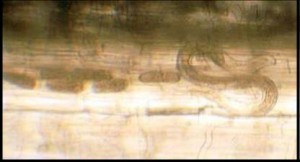
P. penetrans is the most common species of plant-parasitic nematode found in Michigan. It has a wide host range feeding on almost every species of cultivated plant. Many weeds also serve as good hosts. In addition to its role as a pathogen, P. penetrans also predisposes plants to invasion by some genera of soil fungi including Cylindrocarpon, Fusarium, Pythium, Rhizoctonia and Verticillium.
Lesion nematodes, principally P. penetrans, are implicated in the black root rot disease complex of strawberry. In Connecticut, it was demonstrated lesion nematodes and Rhizoctonia fragariae interacted to more than double the development of strawberry black root rot under controlled conditions.
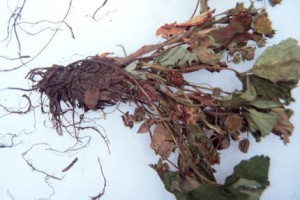
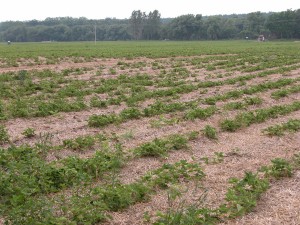
Damage by P. penetrans is greatest on light soils where a damage threshold of 50/100g of soil has been reported. The threshold is probably as low as 10/100 cm3 if R. fragariae is also present.
Lesion nematodes are very difficult to control using crop rotation. Pearl millet has been used successfully in Michigan to reduce population densities of P. penetrans. The most effective control strategy is to use nursery stock free from P. penetrans. Assuming most strawberry sites are infested with R. fragariae, decline of a new planting will be very rapid if the new plants are infested with nematodes. Strawberry varieties differ in their susceptibilities to black root rot. Studies done in Massachusetts indicate “Jewel” is tolerant to R. fragariae. Soil fumigation will effectively control black root rot. Good weed control is also imperative.
Northern Root-Knot Nematodes (Meloidogyne hapla)
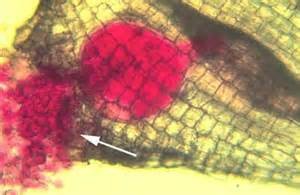
M. hapla is a serious pathogen of fruit and vegetable crops in Michigan. Unlike most plant-parasitic nematodes, feeding by root-knot nematodes results in the production of characteristic symptoms on roots called galls. M. hapla feeding results in very small galls (swellings) and these are often inconspicuous on some hosts. Root-knot nematodes have very high reproductive potentials as single females can produce up to 500 eggs.
In warm, sandy soils, attack by M. hapla can cause severe stunting. Death is more likely to occur if other plant pathogens are involved. Problems are most severe during periods of drought because root-knot nematode-infested plants often seem starved for water.
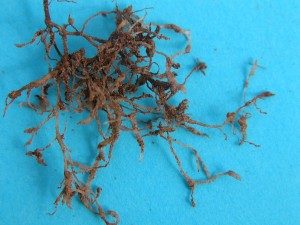
Population densities of the northern root-knot can be reduced by growing grasses because they are non-host crops. Typically, two years out of strawberries is recommended. Planting nematode-free runners is imperative especially on fumigated sites. Cultivars with polygenic resistance to M. hapla have been bred in Europe and varieties differ in their tolerances to the nematode. However, this information is not always reported or readily available.
Needle Nematodes (Longidorus sp.)
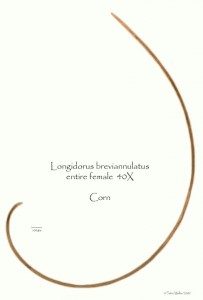
Needle nematodes are the longest plant-parasitic nematodes known to occur in Michigan with adults measuring up to 6 mm (about 1/4 inch). They are typically confined to very sandy soils, preferring sites with sand contents above 70%. These nematodes can be difficult to diagnose during the summer because they often migrate to depths of 24-36 inches to avoid temperature and moisture stress. Adults can live 2-5 years but have low reproductive potentials producing approximately 20 eggs per year.
Needle nematodes are very destructive pathogens of strawberry. Infected plants are severely stunted and roots may exhibit small swellings near their tips. A population density of 180 L. elongatus/200g soil was documented to reduce yield of strawberry 50% in England.
Population densities of needle nematodes can be reduced by growing non-host crops, such as most vegetables (not celery or onions), for two years. Excellent needle nematode control was achieved on a farm in MI by growing broccoli, chopping and incorporating the leaves and stems following harvest and covering the area with plastic. Soil fumigation is an effective control tactic but should be done in the spring or fall when the nematodes are closer to the soil surface.
Dagger Nematodes (Xiphinema americanum)
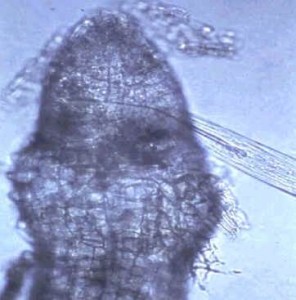
Dagger nematodes are also large plant-parasitic nematodes with adults measuring about 2 mm. They are pathogens of strawberry but are generally of greater concern to small and tree fruit producers because they are capable of transmitting nematode-transmitted polyhedral (nepo) viruses. In strawberry, tomato ringspot virus (ToRSV) is the only nepovirus documented to occur in the US and is generally not a major problem. Symptoms of ToRSV in strawberry range from none to dwarfing, reduced runner production, and mottling to death of leaves or entire plants depending on cultivar.
The biology of dagger nematodes is similar to that of needle nematodes. Control strategies and tactics are also the same. Wild strawberry can host ToRSV, so control of this weed is important. Excellent control can be achieved by growing rapeseed cv. Dwarf Essex, as a cover and/or biofumigation crop. Dagger and needle nematodes can often be controlled by frequent soil cultivation.
Foliar and Stem Nematodes (Aphelenchoides sp. and Ditylenchus dipsaci)
Unlike most species of plant-parasitic nematodes which invade roots, these are foliar pests. These nematodes have extremely wide hosts ranges with many weeds also serving as hosts. They have short life cycles (egg to adult in 14 days) and fairly high reproductive potentials, so they can increase in number very rapidly. Both types of nematodes occur in Michigan but have not regularly been associated with problems in strawberry plantings. Foliar nematodes are typically problems in green or glasshouses whereas; stem nematodes are important pests in nurseries especially on herbaceous perennials and any plants propagated by bulbs, corms or tubers.
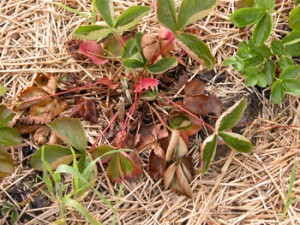
In strawberries, these nematodes cause distortion of the leaves. Damage by Aphelenchoides sp. is most noticeable on newly formed leaves soon after growth is initiated in the spring (“spring dwarf”). However, symptoms may also become evident in the fall. Veins often act as barriers to foliar nematode movement, so symptoms are often interveinal appearing as grayish spots that may turn brown. Leaves are often puckered and distorted. Damage by stem nematodes, D. dipsaci, involves distortion and thickening of the leaves and stems.
Foliar nematodes are potentially destructive pathogens of strawberry. Experiments in Germany demonstrated Aphelenchoides sp. reduced yields up to 65%.
It is imperative healthy runners are planted into nematode-free soil. Any strawberry plants diagnosed with these nematodes should be rogued out as well as 3-5 of its nearest neighbors. Both foliar and stem nematodes are highly resistant to desiccation and can survive in old leaf tissue up to 2 years or more. If a site is infested, bare fallow is the best tactic especially for Aphelenchoides sp. Good weed control is critical. Strawberry nursery stock can be treated with a nematicide but there are no products labeled for bearing plants.
Conclusions
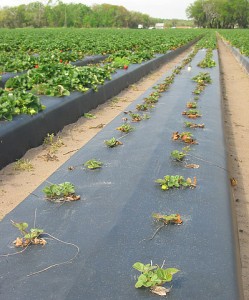
To properly detect and diagnose nematode problems, collection of soil and plant tissue (roots and leaves) samples is necessary. These samples must be sent to a Nematode Lab, such as Plant and Pest Diagnostics at MSU, for analyses. No one nematode management strategy or tactic, with the exception of soil fumigation, will effectively control all the plant-parasitic nematodes reported to feed on strawberry. To develop and implement sound nematode management programs, the types of nematodes present in any given location must be identified. Strawberry producers need to be mindful of the fact that management decisions for nematodes must be implemented before transplants go into the ground as there are no post-plant chemical control options for bearing plants. For concerns or questions about nematodes on strawberry or other crops, feel free to call Angela Tenney (517-353-8563).



 Print
Print Email
Email




